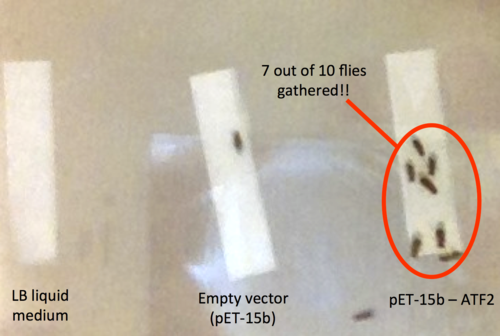Uiuce bus model
From 2013.igem.org
Ashleysmoy (Talk | contribs) (Undo revision 341062 by Ashleysmoy (talk)) |
|||
| Line 473: | Line 473: | ||
<h3 id="1,SDS-PAGE" style="margin-top:-70px; padding-top:70px;" > | <h3 id="1,SDS-PAGE" style="margin-top:-70px; padding-top:70px;" > | ||
<p><b><font size="5">1,SDS-PAGE</font></b></p></h3> | <p><b><font size="5">1,SDS-PAGE</font></b></p></h3> | ||
| - | <p> | + | <p>.</p> |
<div class="thumbnail" style="width:800px; margin: 0 auto;" > | <div class="thumbnail" style="width:800px; margin: 0 auto;" > | ||
| Line 482: | Line 482: | ||
</div> | </div> | ||
<br> | <br> | ||
| - | < | + | <p> |
| - | + | ||
| - | + | ||
<br> | <br> | ||
Revision as of 22:40, 27 October 2013
Business Model
Competitive Analysis
We are trying to construct a novel E.coli that has fruity flavor like Japanese rice wine (Japanese sake). In order to accomplish the purpose, yeast genes related with production of the Japanese sake fragrance were introduced into E. coli cells. We also tried to develop a way to eliminate bad smells of E. coli in parallel. Although we previously won a gold prize by the development of a novel pen (E. coli Pen) in 2010, its bad smells were weak points and must be improved. We will overcome this problem through the progress of our new project in 2013. So far, “smell” is not a popular keyword and not a major field in iGEM. However, we believe that our project will provide a new point of view to iGEM friends.
Market Penetration Strategys
1,SDS-PAGE
.

2,Growth curves
We measured the turbidities of the transformants every 2 hour and made the growth curves. We transferred the transformant prepared to 100 mL flasks and add 660uL IPTG and 108uL isoamyl alcohol to them after 2 hours of the start. We measured the turbidities every 2 hour. The measurements were carried out for 12 hours.
LB 100mL
ampicillin 150uL
sample 50uL
IPTG 660uL
isoamyl alcohol 108uL
37°C, 125/min

In addition, we measured the turbidities of the transformants without adding IPTG and isoamyl alcohol too. We measured 4 samples; ATF2-pET-15b, ATF2-pET-15b + IPTG, empty pET-15b, empty pET-15b + IPTG.
As the result, ATF2-pET-15b transformants grow well relative to control(transformants having empty pET-15b vector). We propose the folllowing hypothesis. Isoamyl acetate indicates a stimulatory effect of growth on E.coli cells when compared to isoamyl alcohol so that transformants having ATF2-pET-15b grow well relative to control.
And ATF2-pET-15b without IPTG grow well relative to ATF2-pET-15b add IPTG. It is explained by the following hypothesis. When we add IPTG to the transformant having ATF2-pET-15b, ATF2 protein (AATase) is expessed in bulk in the transformant. A massive amount of AATase has a potential to surpress the growth.
3, Bioassay using Drosophila
Next, to confirm the activity of AATase, we added isoamyl alcohol after IPTG induction and cultivated for about 2 hours. We used E. coli cells carrying the empty vector (pET-15b) as a control and compare it with the E.coli cells carrying pET15b-ATF2 after addition of isoamyl alcohol. To compare the production of isoamyl acetate, we carried out a bioassay using Drosophila. Because Drosophila favors the fruit odor like isoamyl acetate. [1]
After the addition of IPTG and isoamyl acetate, the culture was impregnated into the filter and placed in a case containing 10 Drosophilas. We monitored the behavior of Drosophila. This is the result. For 1 hour, 7 flies gathered to the ATF2. These results clearly indicate that ATF2 produces isoamyl acetate from isoamyl alcohol.


This is the result. For 1 hour, 7 flies gathered to the ATF2. These results clearly indicate that ATF2 produces isoamyl acetate from isoamyl alcohol.
4,The comparing with the ability of ATF1 and ATF2
In addition, according to the previous study [2], the ability of ATF2 protein to produce isoamyl acetate in yeast is higher than that of ATF1 protein.
It is known that both ATF1 and ATF2 protein are involved in producing isoamyl acetate.

In 2006, MIT iGEM team submitted ATF1 coding sequence. (BBa_J45006) Our new part, ATF2 coding sequence, fall under the category of the improvement of function existing BioBrick Part, BBa_J45006. Herewith, our team, KIT-Kyoto 2013 iGEM team, meets the additional requirements for a Gold Medal.
 "
"

